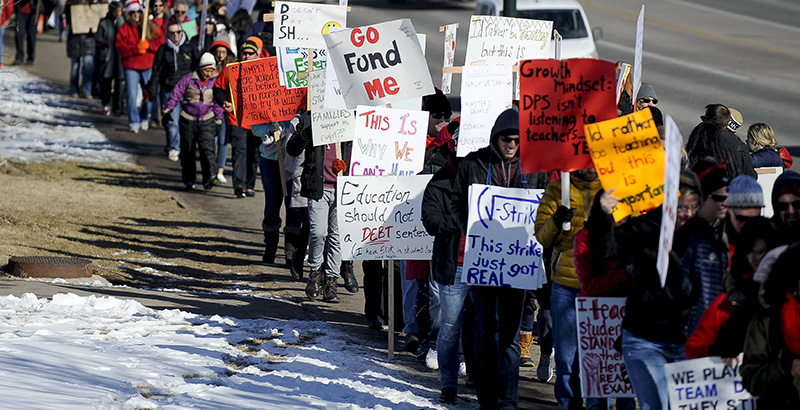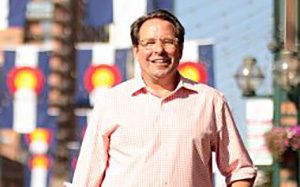Schoales: 7 Education Reform Lessons From the Denver Teacher Strike That Can Help Us Build the Public Schools We Need

Denver’s first teacher strike in 25 years marks a turning point in Colorado, and possibly the nation’s efforts to reform public education.
While many in the education reform community see the strike as a clear sign that education reform as we have known it is over (I mostly agree), I believe it may set the stage for a deeper set of improvements to public education that have eluded us.
The strikes in Los Angeles, Chicago, Denver, West Virginia, and now Oakland have had as much to do with teacher frustrations over how they have been treated by the reform movement as with how much they have been paid. It appears many teachers feel as if reform was pushed upon them, whether new teacher evaluation systems or increased testing without incorporating solutions to the problems they face in their schools.
According to a PDK poll released last summer, teacher job satisfaction has dropped, along with the profession’s appeal among members of the public.
I have been at this work as a teacher, administrator, and advocate for 30 years. I entered the profession wanting to change schools from the inside with my fellow teachers. Some of those efforts worked, laying the groundwork for the development for many of our nation’s highest-performing public schools, while other aspects of that reform movement failed to take off because of structural, leadership, or culture challenges in the system that were too difficult to overcome.
Overall, schools have gotten far better. We made a great leap with American public education in the 20th century. But we have not kept up with the needs of a mid-21st century society. So what are we going to do to accelerate improvement?
Combining an honest assessment of what has succeeded and failed with a deep understanding of what can be done today, we have the chance to build a public education system that works for most everyone — students, parents, teachers, and the community. This will not be accomplished in a few years, but it can be built over the next decade or two, like a great cathedral, if we stick to a focus on getting all students prepared for life, democracy, and work, with regular reflection on progress and challenges.
Here are seven lessons from Denver’s teacher strike that might get us the public schools we need:
1. Include teachers: Reform efforts must include educators if they are to have a lasting impact. Teachers and their unions can push for reforms, as they have for greater funding, or undermine reforms if they are not seen to benefit a teacher’s impact on learning or job satisfaction. Interestingly, Denver’s ProComp system of bonus pay started out as an example of what can be done when a teachers union and reformers work together. It seemed to come off the rails when the district forced changes to ProComp without investing in bringing teachers along. The district overplayed its hand with few tangible benefits for most teachers.
2. Start with what works: Unproven technocratic fixes rarely work and can carry a heavy political cost. Colorado Senate Bill 191, which changed teacher evaluation practices in 2010, and similar legislation in other states were well-intentioned fixes to a broken teacher evaluation and tenure system. TNTP’s report The Widget Effect is a reminder of why these policies were generated: The vast majority of teachers get glowing evaluations and little helpful feedback, are awarded tenure almost universally, and then are nearly impossible to terminate regardless of what they do. While the intent of the reforms was right, solutions that included using value-added standardized test scores and rigid statewide standards on teacher evaluations led to a new bureaucracy that only enraged teachers and administrators, doing little to address the primary problems. It was a classic Pyrrhic victory that only set back long-term efforts to improve schools.
3. Begin with schools, not classrooms: Although the teacher is one of the most important factors in a student’s development, schools are the places that support (or don’t) teachers in their work. A positive school culture and leader matter far more than teacher compensation, evaluation procedures, or the latest smartboard (as helpful as each can be). Teachers work within a school community, and that community can have a powerful impact on what happens in that teacher’s classroom. Reform efforts that have focused more on schools and school leaders — whether the charter school movement, community schools, new school instructional designs, or innovation schools — seem to have had greater impacts on student achievement and last longer.
4. Include community from the start: Reform, no matter how well-intentioned, must be driven by community, not done to community. Many reforms have been top-down and often made a great deal of sense from a policy perspective. The problem was that there was little or no support in the neighborhoods or schools where the reforms were being implemented. Who wants a school closed, even if it is shown to be failing, unless those most being affected can see how they will benefit (and not just in some fuzzy future, but next year)? Reformers must invest in building community understanding for what is going on and is possible in that community. People fear loss, not change, and any improvements must be met with a real commitment to deliver with and alongside the community’s members. This is a long-term proposition, not done in short cycles.
5. Community-based advocacy works: Positive transformation is possible even in a contentious negotiation. The teachers union and Denver Public Schools agreed to significant incentives for the most disadvantaged schools even when the union wanted to return to a pay scale that treats all teachers the same. Advocacy from grassroots community groups and civil rights organizations played a role in pushing both sides to not only keep the incentives but also raise the amounts while negotiations transpired.
6. No quick fixes; tinkering wins the day: Education reform history is marked mostly by slow progress over decades, with a great deal of noise over simple, quick fixes that come and go. Television, then the internet, and now personalized learning are meant to revolutionize public education. The big reform fixes never materialize, but steady, slow efforts focused on schools and their improvement through a variety of less sexy efforts often result in positive change over time. Because people want change now, leaders must help them understand what is possible, what needs to be reformed, and how to get there.
7. Use a split screen: Admittedly somewhat counter to the previous lesson, reformers collectively must work on fixing the current system while building new paradigms of public education designed to educate most of the population at the levels needed today. We need to put equal effort into improving the current system while creating new systems and schools. I am not sure what the ideal new system would look like, but I do have some notions of the designs needed to engage most kids in lifelong learning — and it is not a factory model that groups kids in rows of desks listening to a teacher, doing worksheets, or completing simple multiple-choice tests. At the current rate of improvement (flat to a few percent a year), the system we have will not get us the education required for our democracy or our economy. Yet we need to continue making progress, even if slow, because a few percent increase a year impacts thousands of students and makes the difference in whether they can contribute to society or are a burden.
So what do we need to stop, start, or continue doing? Reformers must work directly with community and grassroots organizations so the work is more grounded. They must support local leaders as they initiate action rather than always taking the lead. They must do far more to collaborate to build coalitions for change — especially with others that they may disagree with— to find places to work together for positive change.
I come out of the teacher strike optimistic, reflecting on our work and committed to doing even more to support the schools that all kids deserve.
Van Schoales is chief executive officer of the nonprofit “action tank” A+ Colorado. He has 30 years’ experience leading education reform efforts from the classroom to the statehouse. He has also helped found a number of other nonprofit groups, including the Odyssey School, Denver School of Science and Technology, Democrats for Education Reform Colorado, Bay Area Coalition of Equitable Schools, and Chalkbeat Colorado.
Get stories like these delivered straight to your inbox. Sign up for The 74 Newsletter

;)
